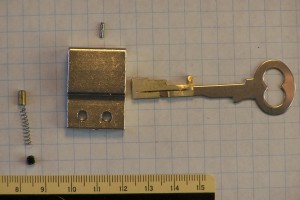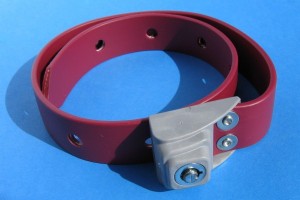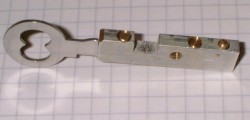
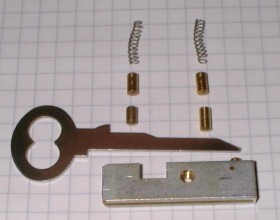
Verschlußschieber des Humane Restraint Verschlusses, bei eingeführtem Schlüsselblech werden die Stifte im Metallblock auf die richtige Höhe angehoben, um die Sperrstifte zu deblockieren. Rechts im Bild kann man die kompletten Innereien sehen und erkennt an der Unterseite des Metallblocks auch den Schlitz, in welchen man das Schlüsselblech einführen kann.
Locking slider of a Humane Restraint locking buckle.
If the flat key is inserted into the key slit the pins within the metal block
are raised to the correct height to deblock the mechanism.
On the photo to the right one can see the complete inner components.
On the bottom of the betal block one also notices the slit into
which the flat key is inserted.
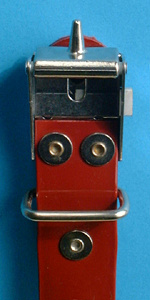
Hier kann man erkennen, wie nach Herunterklappen die Verschlußnase durch das Einschieben des Metallblocks am Wiederhochklappen gehindert werden kann. Hier im Photo ist er halb eingeschoben. Wenn man den Metallblock komplett einschiebt, rasten die Sperrstifte in den Löchern ein und verhindern das Zurückschieben.
One can see that after closing the flap with the locking nose
the metal slider when pushed sideways prevents the flap from being
opened again. On this photo here the slider is pushed half way.
Once the metal block is completely slid into the locking position
the locking pins do engage and prevent the metal slider to
be pushed back into the open position.
Hier nun eine Sequenz von vier Photos, welche die einzelnen Schritte beim Verschließen der Gürtelschnalle aufzeigt.
Below one can see in a sequence of four photos how the locking buckle is closed.
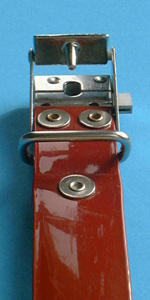
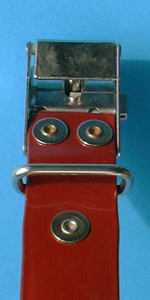
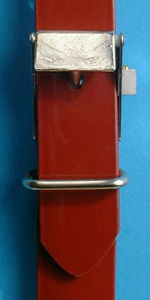
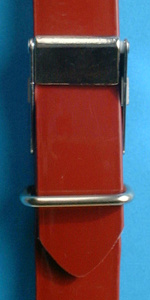
Durch Zug auf das eingeführte Gürtelende wird aber auch ohne Verriegelung die Verschlußnase untengehalten. Der Schloßmechanismus selbst wird nicht auf Zug belastet, da man auf jeden Fall (so man kann) das Gürtelende erstmal weiter hineinschieben muß, um die Nase wieder aufklappen zu können.
If one pulls at the inserted belt the flap stays in the lowered position even without the locking mechanism being engaged. The locking mechanism itself is not under stress because in any case (provided one can) the belt first has to be pushed further inwards in order to be able to raise the locking flap.
Der Verschluß kommt in einer Reihe von Produkten aus dem Haus Humane Restraint zum Einsatz.
This locking buckle is found in a number of Humane Restraint products.
Humane Restraint benutzt noch ein paar andere Schlösser mit seinen Produkten. Links eine simplere Variante des obigen Mechanismus (Danke Dorson für das Foto), rechts eine Neuerung, die so wie es aussieht den obigen Mechanismus ersetzen wird.
Humane Restraint uses some different locking mechanisms as well. To the left a simpler version of the mechanism described above (thanks Dorson for the photo), to the right a newly introduced lock that apparently is going to replace the above mechanism.
